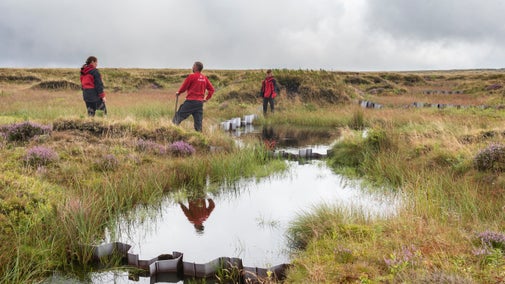
Donate
Everyone needs nature, now more than ever. Donate today and you could help people and nature to thrive at the places we care for.

Find out how cattle are improving the habitat in Portnaboe near the world-renowned Giant’s Causeway. Learn more about our work to create space for wildflowers to grow and discover how wildlife is benefitting, including extremely rare snails and flies.
Dexter cows are a traditional Irish breed and have been chosen for their small size, hardiness and agility on the bay’s rocky slopes. The cows will graze happily on the coarse vegetation found around the cliffs.
Bracken, bramble and coarse grasses are part of their daily diet on the steep maritime slopes of Portnaboe. By grazing, the cattle make space for wildflowers to grow. Dung from the cows even attracts a variety of bats, beetles and other insects.

The rangers have discovered several rare species at the site including the first records anywhere in Northern Ireland of the UK’s gall-forming fly. The gall was found during a bio survey of the landscape by ranger, Cliff Henry.
– Cliff Henry, Area Ranger for the National Trust
The rare rough meadowsweet gall uses the wild meadowsweet plant as a home during part of its life cycle. The gall creates unsightly bumps at the base of the leaves near the stem which are home to colonies of gall fly larvae.
Blemishes or outgrowths on the plant appear due to the burrowing larvae. The larvae develop from eggs laid on the plant by the tiny female fly which then burrow within the plant tissue. The gall larvae benefit from nutrients inside the plant and are also well protected from predators.
A narrow-mouthed whorl snail has recently been seen in the vegetation. This is a rare mollusc that measures just 2mm in length. This micro snail has not been found anywhere else in Northern Ireland.
Cattle carrying out regular conservation grazing will continue to provide a home to rare wildlife on these maritime cliffs. Rangers will continue to complete bio surveys of the area in the hope that more rare insects and flowers will be discovered in the future.

The National Trust rangers at the Giant’s Causeway work continuously to maintain existing wildflower meadows. Recently the team have been creating new ones including the colourful wildflower meadow next to the Visitor Centre.
Wildflower meadows are support a rich variety of insect life. In turn other animals like hedgehogs, birds and bats need the insects to feed on. If one group of species is in decline it can lead to the loss of many more.
The ranger team have built a dedicated nesting bank for solitary mining bees nearby at Innisfree Farm. The team used sods of grass, local stones, sand and gravel to create the mud bank. Two bee species have been spotted trying out the new residence, the chocolate mining bee and its parasite, Marshsam’s nomad bee.
Solitary bees often have a short life cycle but their young frequently us the same nesting sites each year. We hope that the numbers will increase each year as the wildflower meadows mature.
With your ongoing support we're able to continue our vital conservation work. Thank you for helping to protect these special places

Everyone needs nature, now more than ever. Donate today and you could help people and nature to thrive at the places we care for.

Explore Ireland’s only UNESCO World Heritage site. Walk on the world-famous stones, see the basalt columns & soak up dramatic views of the rugged coastline

Almost 60 million years in the making and counting, discover the history of this universally important site & find out how the world-famous stones were formed.

If you're planning a visit to the Giant's Causeway this spring, read this article to find out everything you need to know.

We believe that nature, beauty and history are for everyone. That’s why we’re supporting wildlife, protecting historic sites and more. Find out about our work.

Read about our strategy, which focuses on restoring nature, ending unequal access and inspiring more people.

Together, we're securing our future with action on climate and the environment. Learn more about how we're responding to the changing climate at places in our care.